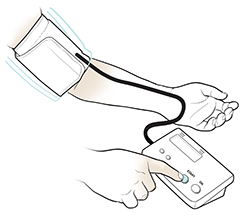Your blood pressure today was higher than normal. Sometimes anxiety, pain, or other issues can cause a short-term rise in blood pressure. It later returns to normal. Blood pressure that is high only once doesn’t mean that you have high blood pressure (hypertension). High blood pressure is a long-term (chronic) illness. But you should have your blood pressure measured again in the next few days to find out if it’s still high.
Blood pressure measurements are given as 2 numbers. Systolic blood pressure is the upper number. This is the pressure when the heart contracts. Diastolic blood pressure is the lower number. This is the pressure when the heart relaxes between beats. You will see your blood pressure readings written together. For example, a person with a systolic pressure of 118 and a diastolic pressure of 78 will have 118/78 written in the medical record.
Blood pressure is classified as normal, raised (elevated), or stage 1 or stage 2 high blood pressure.
-
Normal blood pressure. Systolic of less than 120 and diastolic of less than 80 (120/80).
-
Elevated blood pressure. Systolic of 120 to 129 and diastolic less than 80.
-
Stage 1 high blood pressure. Systolic is 130 to 139 or diastolic between 80 to 89.
-
Stage 2 high blood pressure. Systolic is 140 or higher or the diastolic is 90 or higher.
Lifestyle changes can help manage your blood pressure. These include weight loss, exercise, and quitting smoking. Have your blood pressure checked regularly to be sure it's under control.
Home care
To track your blood pressure, your health care provider may ask you to come into the office at different times and on different days. If your provider asks you to check your readings at home, ask them what times of the day to test and for how many days. Before you leave the office, ask your provider to show you how to take your blood pressure. Ask questions if you don't understand something.
Using a home blood pressure monitor
Think about buying an automatic blood pressure monitor. Ask your provider for a recommendation as well as the correct size cuff to fit your arm. You can buy blood pressure monitors at most pharmacies.
The American Heart Association advises the following guidelines for home blood pressure monitoring:
-
Don't smoke or drink coffee or other caffeinated drinks for 30 minutes before taking your blood pressure.
-
Go to the bathroom before the test.
-
Relax for at least 5 minutes before taking the measurement.
-
Sit with your back supported (don't sit on a couch or soft chair). Keep your feet on the floor uncrossed. Place your arm on a solid flat surface (like a table) with the upper part of the arm at heart level. Place the middle of the cuff directly above the bend of the elbow. Do not take measurements over clothing. Check the monitor's instruction manual for an illustration.
-
Take multiple readings. When you measure, take 2 or 3 readings 1 minute apart. Record all of the results.
-
Take your blood pressure at the same time every day, or as your provider advises.
-
Record the date, time, and blood pressure reading.
-
Take the record with you to your next medical appointment. If your blood pressure monitor has a built-in memory, simply take the monitor with you to your next appointment.
-
Call your provider if you have several high readings. Don't be frightened by a single high blood pressure reading. But if you get a few high readings, check in with your provider.
Follow-up care
Go to all of your follow-up appointments. If your blood pressure is more than 120 over 80 on 2 out of 3 days, you will need to follow up with your health care provider for more evaluation and treatment.
Don’t put this off! High blood pressure can be treated. High blood pressure that’s not treated raises your risk for heart attack, heart failure, kidney disease, and stroke.
Call 911
Call
-
Blood pressure of 180/120 or higher, along with any symptoms listed below
-
Unusual chest pain or shortness of breath
-
Weakness of an arm or leg or one side of the face
-
Problems speaking or seeing
-
Severe headache
-
Sudden severe pain in your belly (abdomen)
-
Extreme drowsiness, confusion, or fainting
-
Severe or persistent dizziness or spinning feeling (vertigo)
When to get medical advice
Contact your health care provider or get medical care right away if you have:
-
Blood pressure of 180/120 or higher after testing several times, without other symptoms.
-
Throbbing or rushing sound in the ears.
-
Nosebleed.
-
Mild or intermittent dizziness or spinning feeling (vertigo).



